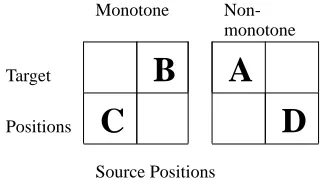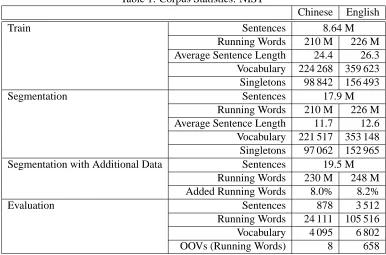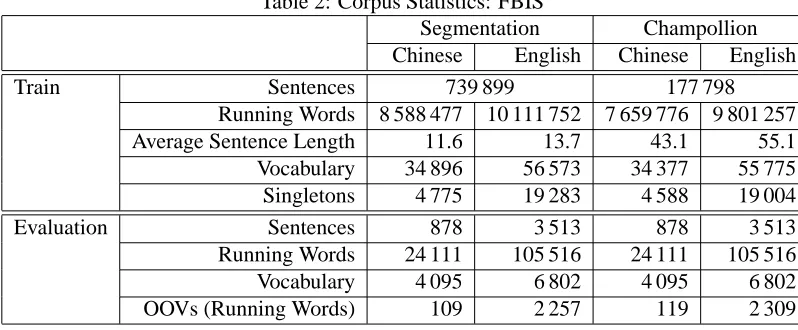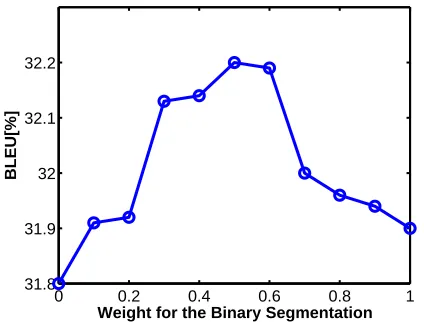Partitioning Parallel Documents Using Binary Segmentation
Jia Xu and Richard Zens and Hermann Ney Chair of Computer Science 6
Computer Science Department RWTH Aachen University D-52056 Aachen Germany
{xujia,zens,ney}@cs.rwth-aachen.de
Abstract
In statistical machine translation, large numbers of parallel sentences are required to train the model parameters. However, plenty of the bilingual language resources available on web are aligned only at the document level. To exploit this data, we have to extract the bilingual sentences from these documents.
The common method is to break the doc-uments into segments using predefined anchor words, then these segments are aligned. This approach is not error free, incorrect alignments may decrease the translation quality.
We present an alternative approach to ex-tract the parallel sentences by partitioning a bilingual document into two pairs. This process is performed recursively until all the sub-pairs are short enough.
In experiments on the Chinese-English FBIS data, our method was capable of producing translation results comparable to those of a state-of-the-art sentence aligner. Using a combination of the two approaches leads to better translation per-formance.
1 Introduction
Current statistical machine translation systems use bilingual sentences to train the parameters of the
translation models. The exploitation of more bilin-gual sentences automatically and accurately as well as the use of these data with the limited computa-tional requirements become crucial problems.
The conventional method for producing parallel sentences is to break the documents into sentences and to align these sentences using dynamic program-ming. Previous investigations can be found in works such as (Gale and Church, 1993) and (Ma, 2006). A disadvantage is that only the monotone sentence alignments are allowed.
Another approach is the binary segmentation method described in (Simard and Langlais, 2003), (Xu et al., 2005) and (Deng et al., 2006), which separates a long sentence pair into two sub-pairs re-cursively. The binary reordering in alignment is al-lowed but the segmentation decision is only opti-mum in each recursion step.
Hence, a combination of both methods is ex-pected to produce a more satisfying result. (Deng et al., 2006) performs a two-stage procedure. The documents are first aligned at level using dynamic programming, the initial alignments are then refined to produce shorter segments using binary segmen-tation. But on the Chinese-English FBIS training corpus, the alignment accuracy and recall are lower than with Champollion (Ma, 2006).
are linear interpolated using the corpus weights. In the experiments on the Chinese-English FBIS cor-pus the translation performance is improved by 0.4% of the BLEU score compared to the performance only with Champollion.
The remainder of this paper is structured as fol-lows: First we will briefly review the baseline statis-tical machine translation system in Section 2. Then, in Section 3, we will describe the refined binary seg-mentation method. In Section 4.1, we will introduce the methods to extract bilingual sentences from doc-ument aligned texts. The experimental results will be presented in Section 4.
2 Review of the Baseline Statistical Machine Translation System
In this section, we briefly review our translation sys-tem and introduce the word alignment models.
In statistical machine translation, we are given a source language sentence f1J = f1. . . fj. . . fJ, which is to be translated into a target language sen-tenceeI1 = e1. . . ei. . . eI.Among all possible tar-get language sentences, we will choose the sentence with the highest probability:
ˆ
The decomposition into two knowledge sources in Equation 1 allows independent modeling of tar-get language model P r(eI1) and translation model P r(fJ
1|eI1)1. The translation model can be further extended to a statistical alignment model with the following equation: ‘hidden’ word alignmenta=aJ
1, which describes a mapping from a source positionjto a target position aj.
1The notational convention will be as follows: we use the
symbolP r(·)to denote general probability distributions with (nearly) no specific assumptions. In contrast, for model-based probability distributions, we use the generic symbolp(·).
Monotone Non-monotone
Target
B
A
Positions
C
D
Source Positions
Figure 1: Two Types of Alignment
The IBM model 1 (IBM-1) (Brown et al., 1993) assumes that all alignments have the same probabil-ity by using a uniform distribution:
p(f1J|eI1) = 1
We use the IBM-1 to train the lexicon parameters p(f|e), the training software is GIZA++ (Och and Ney, 2003).
To incorporate the context into the translation model, the phrase-based translation approach (Zens et al., 2005) is applied. Pairs of source and tar-get language phrases are extracted from the bilin-gual training corpus and a beam search algorithm is implemented to generate the translation hypothesis with maximum probability.
3 Binary Segmentation Method
3.1 Approach
Here a document or sentence pair(f1J, eI1)2is repre-sented as a matrix. Every element in the matrix con-tains a lexicon probabilityp(fj|ei), which is trained on the original parallel corpora. Each position di-vides a matrix into four parts as shown in Figure 1: the bottom left (C), the upper left (A), the bottom right (D) and the upper right (B). We usem to de-note the alignment direction,m= 1means that the alignment is monotone, i.e. the bottom left part is connected with the upper right part, and m = 0 means the alignment is non-monotone, i.e. the upper left part is connected with the bottom right part, as shown in Figure 1.
3.2 Log-Linear Model
We use a log-linear interpolation to combine differ-ent models: the IBM-1, the inverse IBM-1, the
an-2
chor words model as well as the IBM-4.K denotes the total number of models.
We go through all positions in the bilingual sen-tences and find the best position for segmenting the sentence: tions in the source and target sentences respectively. The feature functions are described in the follow-ing sections. In most cases, the sentence pairs are quite long and even after one segmentation we may still have long sub-segments. Therefore, we separate the sub-segment pairs recursively until the length of each new segment is less than a defined value.
3.3 Normalized IBM-1
The function in Equation 2 can be normalized by the source sentence length with a weightingβas de-scribed in (Xu et al., 2005):
The monotone alignment is calculated as
h1(j, i,1|f1J, eI1) = log(p(f1j|ei1)β· 1
j+(1−β) (3)
·p(fj+1J |eIi+1)β·J−1j+(1−β)),
and the non-monotone alignment is formulated in the same way.
We also use the inverse IBM-1 as a feature, by ex-changing the place ofei1andf1jits monotone align-ment is calculated as:
h2(j, i,1|f1J, eI1) = log(p(ei1|f1j)β· 1
i+(1−β) (4)
·p(eIi+1|fj+1J )β·I1−i+(1−β))
3.4 Anchor Words
In the task of extracting parallel sentences from the paragraph-aligned corpus, selecting some anchor words as preferred segmentation positions can ef-fectively avoid the extraction of incomplete segment pairs. Therefore we use an anchor words model to prefer the segmentation at the punctuation marks, where the source and target words are identical:
h3(j, i, m|f1J, eI1) =
½
1 :fj =ei∧ei∈ A
0 :otherwise
Ais a user defined anchor word list, here we use
A={.,”?;}. If the corresponding model scaling factor λ3 is assigned a high value, the segmentation posi-tions are mostly after anchor words.
3.5 IBM-4 Word Alignment
If we already have the IBM-4 Viterbi word align-ments for the parallel sentences and need to retrain the system, for example to optimize the training pa-rameters, we can include the Viterbi word align-ments trained on the original corpora into the binary segmentation. In the monotone case, the model is represented as non-monotone case the model is formulated in the same way.
3.6 Word Alignment Concatenation
As described in Section 2, our translation is based on phrases, that means for an input sentence we extract all phrases matched in the training corpus and trans-late with these phrase pairs. Although the aim of segmentation is to split parallel text into translated segment pairs, but the segmentation is still not per-fect. During sentence segmentation we might sep-arate a phrase into two segments, so that the whole phrase pair can not be extracted.
Table 1: Corpus Statistics: NIST
Chinese English
Train Sentences 8.64 M
Running Words 210 M 226 M
Average Sentence Length 24.4 26.3
Vocabulary 224 268 359 623 Singletons 98 842 156 493
Segmentation Sentences 17.9 M
Running Words 210 M 226 M
Average Sentence Length 11.7 12.6
Vocabulary 221 517 353 148 Singletons 97 062 152 965
Segmentation with Additional Data Sentences 19.5 M
Running Words 230 M 248 M
Added Running Words 8.0% 8.2%
Evaluation Sentences 878 3 512
Running Words 24 111 105 516
Vocabulary 4 095 6 802
OOVs (Running Words) 8 658
4 Translation Experiments
4.1 Bilingual Sentences Extraction Methods
In this section, we describe the different methods to extract the bilingual sentence pairs from the docu-ment aligned corpus.
Given each document pair, we assume that the paragraphs are aligned one to one monotone if both the source and target language documents contain the same number of paragraphs; otherwise the para-graphs are aligned with the Champollion tool.
Starting from the parallel paragraphs we extract the sentences using three methods:
1. Binary segmentation
The segmentation method described in Sec-tion 3 is applied by treating the paragraph pairs as long sentence pairs. We can use the anchor words model described in Section 3.4 to prefer splitting at punctuation marks.
The lexicon parameters p(f|e) in Equation 2 are estimated as follows: First the sentences are aligned roughly using the dynamic program-ming algorithm. Training on these aligned sen-tences, we get the initial lexicon parameters.
Then the binary segmentation algorithm is ap-plied to extract the sentences again.
2. Champollion
After a paragraph is divided into sentences at punctuation marks, the Champollion tool (Ma, 2006) is used, which applies dynamic program-ming for the sentence alignment.
3. Combination
The bilingual corpora produced by the binary segmentation and Champollion methods are concatenated and are used in the training of the translation model. Each corpus is assigned a weight. During the training of the word align-ment models, the counts of the lexicon en-tries are linearly interpolated using the corpus weights.
4.2 Translation Tasks
We will present the translation results on two Chinese-English tasks.
Table 2: Corpus Statistics: FBIS
Segmentation Champollion
Chinese English Chinese English
Train Sentences 739 899 177 798
Running Words 8 588 477 10 111 752 7 659 776 9 801 257
Average Sentence Length 11.6 13.7 43.1 55.1
Vocabulary 34 896 56 573 34 377 55 775
Singletons 4 775 19 283 4 588 19 004
Evaluation Sentences 878 3 513 878 3 513
Running Words 24 111 105 516 24 111 105 516
Vocabulary 4 095 6 802 4 095 6 802
OOVs (Running Words) 109 2 257 119 2 309
2. On the FBIS corpus, we will compare the dif-ferent sentence extraction methods described in Section 4.1 with respect to translation perfor-mance. We do not apply the extraction meth-ods on the whole NIST corpora, because some corpora provided by the LDC (LDC, 2005) are sentence aligned but not document aligned.
4.3 Corpus Statistics
The training corpora used in NIST task are a set of individual corpora including the FBIS corpus. These corpora are provided by the Linguistic Data Consor-tium (LDC, 2005), the domains are news articles. The translation experiments are carried out on the NIST 2002 evaluation set.
As shown in Table 1, there are 8.6 million sen-tence pairs in the original corpora of the NIST task. The average sentence length is about 25. After seg-mentation, there are twice as many sentence pairs, i.e. 17.9 million, and the average sentence length is around 12. Due to a limitation of GIZA++, sen-tences consisting of more than one hundred words are filtered out. Segmentation of long sentences cir-cumvents this restriction and allows us include more data. Here we were able to add 8% more Chinese and 8.2% more English running words to the train-ing data. The traintrain-ing time is also reduced.
Table 2 presents statistics of the FBIS data. Af-ter the paragraph alignment described in Section 4.1 we have nearly 81 thousand paragraphs, 8.6 million Chinese and 10.1 million English running words. One of the advantages of the binary segmentation is that we do not loose words during the bilingual
sen-tences extraction. However, we produce sentence pairs with very different lengths. Using Champol-lion we loose 10.8% of the Chinese and 3.1% of the English words.
4.4 Segmentation Parameters
We did not optimize the log-linear model scaling factors for the binary segmentation but used the fol-lowing fixed values: λ1 = λ2 = 0.5for the IBM-1 models in both directions;λ3 = 108, if the anchor words model is is used;λ4 = 30, if the IBM-4 model is used. The maximum sentence length is 25.
4.5 Evaluation Criteria
We use four different criteria to evaluate the transla-tion results automatically:
• WER (word error rate):
The WER is computed as the minimum num-ber of substitution, insertion and deletion oper-ations that have to be performed to convert the generated sentence into the reference sentence, divided by the reference sentence length.
• PER (position-independent word error rate): A shortcoming of the WER is that it requires a perfect word order. The word order of an ac-ceptable sentence can be differ from that of the target sentence, so that the WER measure alone could be misleading. The PER compares the words in the two sentences ignoring the word order.
• BLEU score:
0 0.2 0.4 0.6 0.8 1
Weight for the Binary Segmentation
BLEU[%]
Figure 2: Translation performance as a function of the weight for the binary segmentation α ( weight for Champollion:1−α)
bigrams, trigrams and fourgrams with a penalty for too short sentences. (Papineni et al., 2002).
• NIST score:
This score is similar to BLEU, but it uses an arithmetic average of N-gram counts rather than a geometric average, and it weights more heavily those N-grams that are more informa-tive. (Doddington, 2002).
The BLEU and NIST scores measure accuracy, i.e. larger scores are better. In our evaluation the scores are measured as case insensitive and with re-spect to multiple references.
4.6 Translation Results
For the segmentation of long sentences into short segments, we performed the experiments on the NIST task. Both in the baseline and the segmenta-tion systems we obtain 4.7 million bilingual phrases during the translation. The method of alignment concatenation increases the number of the extracted bilingual phrase pairs from 4.7 million to 4.9 mil-lion, the BLEU score is improved by 0.1%. By including the IBM-4 Viterbi word alignment, the NIST score is improved. The training of the base-line system requires 5.9 days, after the sentence seg-mentation it requires only 1.5 days. Moreover, the segmentation allows the inclusion of long sentences that are filtered out in the baseline system. Using
the added data, the translation performance is en-hanced by 0.3% in the BLEU score. Because of the long translation period, the translation parame-ters are only optimized on the baseline system with respect to the BLEU score, we could expect a further improvement if the parameters were also optimized on the segmentation system.
Our major objective here is to introduce another approach to parallel sentence extraction: binary seg-mentation of the bilingual texts recursively. We use the paragraph-aligned corpus as a starting point. Ta-ble 4 presents the translation results on the train-ing corpora generated by the different methods de-scribed in Section 4.1. The translation parameters are optimized with the respect to the BLEU score. We observe that the binary segmentation methods are comparable to Champollion and the segmenta-tion with anchors outperforms the one without an-chors. By combining the methods of Champol-lion and the binary segmentation with anchors, the BLEU score is improved by 0.4% absolutely.
We optimized the weightings for the binary seg-mentation method, the sum of the weightings for both methods is one. As shown in Figure 2, using one of the methods alone does not produce the best result. The maximum BLEU score is attained when both methods are combined with equal weightings.
5 Discussion and Future Work
We successfully applied the binary sentence seg-mentation method to extract bilingual sentence pairs from the document aligned texts. The experiments on the FBIS data show an enhancement of 0.4% of the BLEU score compared to the score obtained us-ing a state-of-art sentence aligner. In addition to the encouraging results obtained, further improvements could be achieved in the following ways:
1. By extracting bilingual paragraphs from the documents, we lost running words using Cham-pollion. Applying the segmentation approach to paragraph alignment might avoid the loss of this data.
Table 3: Translation Results using Refined Segmentation Methods on NIST task
Error Rate[%] Accuracy
WER PER NIST BLEU[%]
Baseline 62.7 42.1 8.95 33.5
Segmentation 62.6 42.4 8.80 33.5
Segmentation + concatenation 62.4 42.3 8.84 33.6
Segmentation + concatenation + IBM-4 62.8 42.4 8.91 33.6
Segmentation + added data 62.9 42.5 9.00 33.9
Table 4: Translation Results on Sentence Alignment Task with FBIS Training Corpus
Error Rate[%] Accuracy
WER PER NIST BLEU[%]
Champollion 64.2 43.7 8.61 31.8
Segmentation without Anchors 64.3 44.4 8.57 31.8
Segmentation with Anchors 64.0 43.9 8.58 31.9
Champollion + Segmentation with Anchors 64.3 44.2 8.57 32.2
3. In the binary segmentation method, an incor-rect segmentation results in further mistakes in the segmentation decisions of all its sub-segments. An alternative method (Wu, 1997) makes decisions at the end but has a high com-putational requirement. A restricted expansion of the search space might better balance seg-mentation accuracy and the efficiency.
6 Acknowledgments
This work was supported by the European Union under the integrated project TC-Star (Technology and Corpora for Speech to Speech Translation, IST-2002-FP6-506738, http://www.tc-star.org) and the Defense Advanced Research Projects Agency (DARPA) under Contract No. HR0011-06-C-0023.
References
P. F. Brown, S. A. Della Pietra, V. J. Della Pietra, and R. L. Mercer. 1993. The mathematics of statistical machine translation: Parameter estimation.
Computa-tional Linguistics, 19(2):263–311, June.
Y. Deng, S. Kumar, and W. Byrne. 2006. Segmenta-tion and alignment of parallel text for statistical ma-chine translation. Natural Language Engineering, Ac-cepted. To appear.
G. Doddington. 2002. Automatic evaluation of machine translation quality using n-gram co-occurrence statis-tics. In Proceedings of Human Language Technology, pages 128–132, San Diego, California, March.
W. A. Gale and K. W. Church. 1993. A program for aligning sentences in bilingual corpora. Computa-tional Linguistics, 19(1):75–90.
LDC. 2005. Linguistic data consortium resource home page. http://www.ldc.upenn.edu/Projects/TIDES.
X. Ma. 2006. Champollion: A robust parallel text sentence aligner. In Proceedings of the fifth
interna-tional conference on Language Resources and Evalu-ation (LREC), Genoa, Italy, Accepted. To appear.
NIST. 2005. Machine translation home page. http://www.nist.gov/speech/tests/mt/index.htm.
F. J. Och and H. Ney. 2003. A systematic comparison of various statistical alignment models. Computational
Linguistics, 29(1):19–51, March.
K. A. Papineni, S. Roukos, T. Ward, and W. J. Zhu. 2002. Bleu: a method for automatic evaluation of machine translation. In Proceedings of the 40th Annual
Meet-ing of the Association for Computational LMeet-inguistics,
pages 311–318, Philadelphia, July.
M. Simard and P. Langlais. 2003. Statistical transla-tion alignment with compositransla-tionality constraints. In
D. Wu. 1997. Stochastic inversion transduction gram-mars and bilingual parsing of parallel corpora.
Com-putational Linguistics, 23(3):377–403, September.
J. Xu, R. Zens, and H. Ney. 2005. Sentence segmentation using IBM word alignment model 1. In Proceedings of
EAMT 2005 (10th Annual Conference of the European Association for Machine Translation), pages 280–287,
Budapest, Hungary, May.
R. Zens, O. Bender, S. Hasan, S. Khadivi, E. Matusov, J. Xu, Y. Zhang, and H. Ney. 2005. The RWTH phrase-based statistical machine translation system. In
Proceedings of the International Workshop on Spoken Language Translation (IWSLT), pages 155–162,




